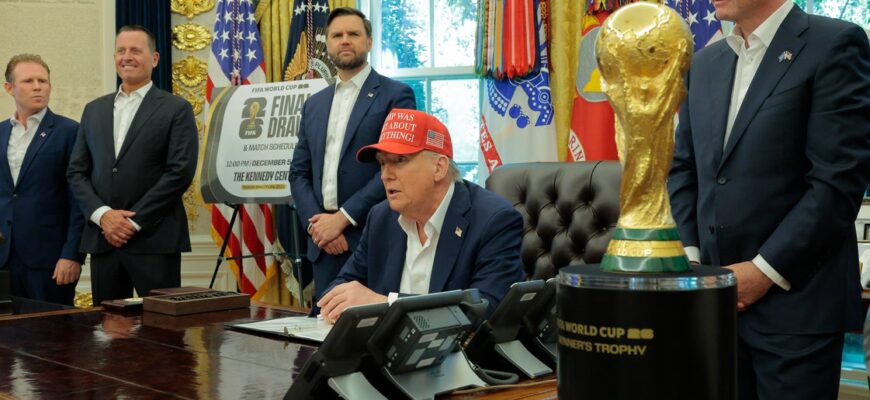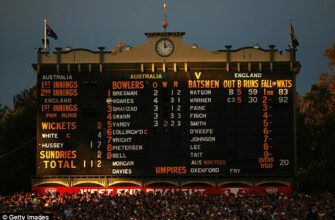In a move that seamlessly blended high politics with global sports, the date and location for the highly anticipated FIFA 2026 World Cup Final Draw were unveiled from a most unexpected venue: the Oval Office. This decisive announcement places Washington, D.C., at the heart of the world’s biggest sporting event before a single ball has been kicked.
- An Unveiling with Unmistakable Flair: D.C.`s Grand Role Confirmed
- A Red Hat, a Trophy, and a `Strong Hand` in Global Planning
- The Draw: Where the Road to 2026 Truly Commences
- A Global Roll Call: The Teams Begin to Emerge
- A Different Stage: Kennedy Center vs. Las Vegas `94 Reimagined
- The Road Ahead: Forging the `Biggest Ever` Sporting Spectacle
An Unveiling with Unmistakable Flair: D.C.`s Grand Role Confirmed
Friday delivered a distinctive mix of international football and American political theater as the critical details for the FIFA 2026 World Cup Final Draw were declared. Former U.S. President Donald Trump, joined by Vice President JD Vance and FIFA President Gianni Infantino, made the announcement from the iconic Oval Office. The prestigious Kennedy Center in Washington, D.C., is now set to host this pivotal event on December 5, at 12 p.m. ET.
This decision represents a notable shift in strategy. Earlier reports had suggested the draw might take place amidst the neon glow of Las Vegas. However, by selecting the nation`s capital, organizers ensure Washington, D.C., secures a central, if symbolic, role in the World Cup narrative. While the city itself will not host any matches during the summer of 2026, its cultural and political gravitas will undoubtedly lend a unique backdrop to the event, perhaps signaling a broader intent for the tournament’s North American tenure to resonate beyond the stadiums.
A Red Hat, a Trophy, and a `Strong Hand` in Global Planning
The announcement was delivered with a characteristic Trumpian flourish. Seated at his desk, and notably sporting a red `Trump Was Right About Everything` hat, the former President oversaw the proceedings. The gleaming World Cup trophy, positioned prominently on his desk, became an immediate focal point. In a lighthearted moment, echoing a previous playful inquiry regarding the Club World Cup trophy, Trump again humorously asked if he might “keep it.”
This seemingly informal exchange, however, hints at a deeper, more hands-on involvement. As the chair of the White House Task Force on the 2026 FIFA World Cup, Trump is positioned to exercise a “strong hand” in shaping the event’s overall presentation and planning. His influence extends beyond mere declarations; it signifies a direct link between the highest echelons of American power and the world’s most watched sporting spectacle. For a tournament aspiring to be the most attended in history, a guiding hand accustomed to grand gestures could be perceived as either a stroke of organizational genius or, depending on one`s political persuasion, a rather bold gamble in the intricate world of international sports diplomacy.
“We are excited to host the most anticipated Final Draw for the FIFA World Cup in history in the cultural and entertainment heart of the United States, the Kennedy Center in Washington, D.C.,” Infantino stated. “The draw is a major tournament milestone and one that will continue the remarkable build-up to the biggest sporting event ever, as we get set for many landmark FIFA events across North America throughout 2026.”
The Draw: Where the Road to 2026 Truly Commences
Indeed, the Final Draw is far more than a mere ceremonial event; it serves as the strategic cornerstone from which the detailed operational planning for the 2026 World Cup truly begins. For the 16 host cities spread across the United States, Canada, and Mexico, this is the moment they will discover which national teams will grace their stadiums. What were once abstract logistical challenges will then transform into concrete, actionable blueprints. From preparing for the linguistic diversity of fan bases to orchestrating the intricate scheduling of team travel and accommodation, this event kickstarts the complex, granular descent of a grand vision into tangible reality.
A Global Roll Call: The Teams Begin to Emerge
The 2026 World Cup`s expanded format will feature an unprecedented 48 teams. While the December draw will determine the group stage matchups for 42 nations, several formidable teams have already secured their coveted spots. Joining the host nations—United States, Canada, and Mexico—are ten international powerhouses:
- Argentina
- Australia
- Brazil
- Ecuador
- New Zealand
- Iran
- Japan
- Jordan
- South Korea
- Uzbekistan
The remaining six spots will be fiercely contested through playoff matches scheduled for March 2026, also slated to take place within the United States. This staggered qualification process ensures a sustained period of global football excitement leading up to the main tournament.
A Different Stage: Kennedy Center vs. Las Vegas `94 Reimagined
The selection of the Kennedy Center offers a stark contrast to the draw for the 1994 FIFA World Cup, which unfolded within the more utilitarian confines of the Las Vegas Convention Center. This architectural and cultural shift, from a functional convention hall to a world-renowned performing arts venue, signifies a deliberate elevation of the World Cup draw itself. It positions the event not merely as a sporting fixture but as a significant cultural happening, reflecting the tournament’s burgeoning global stature and its ambitious mission to transcend traditional boundaries.
The Road Ahead: Forging the `Biggest Ever` Sporting Spectacle
With the 2026 FIFA World Cup poised to be the most attended in history, the precise announcement of the draw’s details ignites a fresh wave of anticipation and urgency. The convergence of political influence, global sports governance, and cultural prestige in Washington, D.C., for this critical milestone underscores the monumental ambition driving North America`s upcoming football spectacle. The stage is now firmly set, the key players are strategically aligned, and the countdown to a truly historic, and undeniably theatrical, tournament has just taken a very official leap forward, promising a World Cup unlike any before it.







